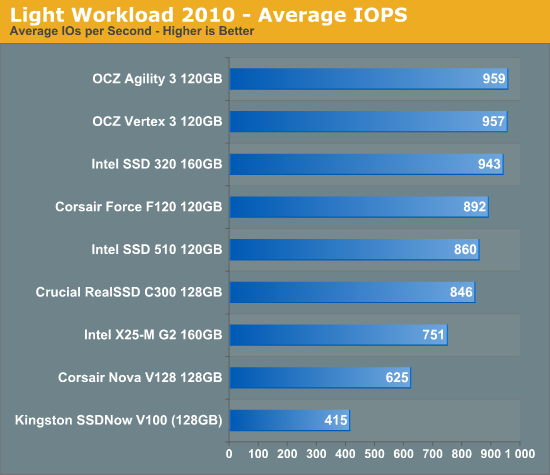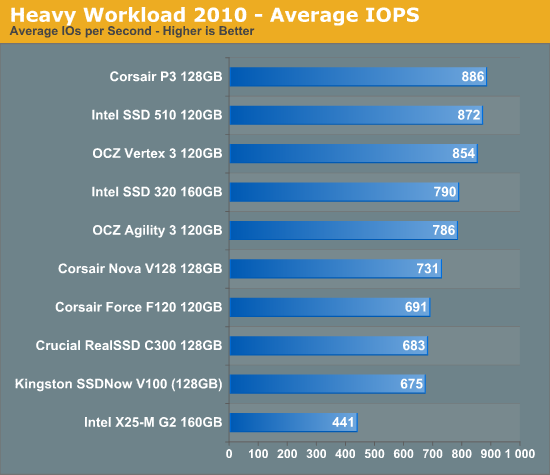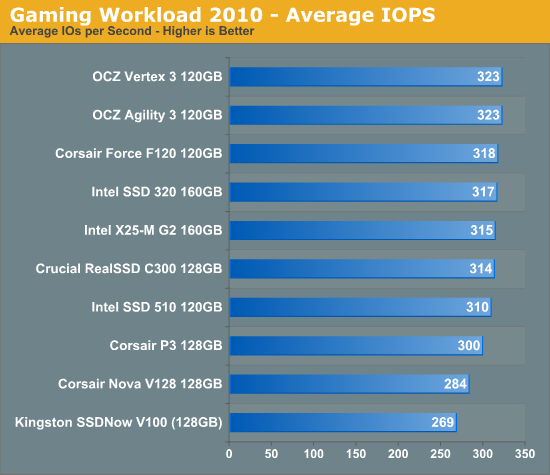The 2011 Mid-Range SSD Roundup: 120GB Agility 3, Intel 510 and More Compared
by Anand Lal Shimpi on June 7, 2011 12:52 PM ESTAnandTech Storage Bench 2010
To keep things consistent we've also included our older Storage Bench. Note that the old storage test system doesn't have a SATA 6Gbps controller, so we only have one result for the 6Gbps drives.
The first in our benchmark suite is a light/typical usage case. The Windows 7 system is loaded with Firefox, Office 2007 and Adobe Reader among other applications. With Firefox we browse web pages like Facebook, AnandTech, Digg and other sites. Outlook is also running and we use it to check emails, create and send a message with a PDF attachment. Adobe Reader is used to view some PDFs. Excel 2007 is used to create a spreadsheet, graphs and save the document. The same goes for Word 2007. We open and step through a presentation in PowerPoint 2007 received as an email attachment before saving it to the desktop. Finally we watch a bit of a Firefly episode in Windows Media Player 11.
There’s some level of multitasking going on here but it’s not unreasonable by any means. Generally the application tasks proceed linearly, with the exception of things like web browsing which may happen in between one of the other tasks.
The recording is played back on all of our drives here today. Remember that we’re isolating disk performance, all we’re doing is playing back every single disk access that happened in that ~5 minute period of usage. The light workload is composed of 37,501 reads and 20,268 writes. Over 30% of the IOs are 4KB, 11% are 16KB, 22% are 32KB and approximately 13% are 64KB in size. Less than 30% of the operations are absolutely sequential in nature. Average queue depth is 6.09 IOs.
The performance results are reported in average I/O Operations per Second (IOPS):

Our old light workload from 2010 highlights an important point about all of these SSDs. For light usage, in a completely IO bound workload, there's only a 13% difference in performance between the fastest 6Gbps drive and last year's C300. If there's only a 13% difference in this completely IO bound test, the real world difference will surely be nonexistent.
If there’s a light usage case there’s bound to be a heavy one. In this test we have Microsoft Security Essentials running in the background with real time virus scanning enabled. We also perform a quick scan in the middle of the test. Firefox, Outlook, Excel, Word and Powerpoint are all used the same as they were in the light test. We add Photoshop CS4 to the mix, opening a bunch of 12MP images, editing them, then saving them as highly compressed JPGs for web publishing. Windows 7’s picture viewer is used to view a bunch of pictures on the hard drive. We use 7-zip to create and extract .7z archives. Downloading is also prominently featured in our heavy test; we download large files from the Internet during portions of the benchmark, as well as use uTorrent to grab a couple of torrents. Some of the applications in use are installed during the benchmark, Windows updates are also installed. Towards the end of the test we launch World of Warcraft, play for a few minutes, then delete the folder. This test also takes into account all of the disk accesses that happen while the OS is booting.
The benchmark is 22 minutes long and it consists of 128,895 read operations and 72,411 write operations. Roughly 44% of all IOs were sequential. Approximately 30% of all accesses were 4KB in size, 12% were 16KB in size, 14% were 32KB and 20% were 64KB. Average queue depth was 3.59.

Our heavy workload is really no different in terms of the performance spread. All of the newer drives show very similar performance.
The gaming workload is made up of 75,206 read operations and only 4,592 write operations. Only 20% of the accesses are 4KB in size, nearly 40% are 64KB and 20% are 32KB. A whopping 69% of the IOs are sequential, meaning this is predominantly a sequential read benchmark. The average queue depth is 7.76 IOs.











68 Comments
View All Comments
voidi - Wednesday, June 8, 2011 - link
I've been waiting for an article like this for a long time. I think there are more people interested in the middle-class, 120GB SSDs, because everything above that capacity is still very expensive, and 120GBs should prove sufficient for most users to store the OS + a load of programs + all games you currently play from time to time. Twice the space is always nice, of course, but I don't feel it's necessary.Thank you so much for this review!
voidi - Wednesday, June 8, 2011 - link
By the way, in Europe, the Agility 3 120GB is currently ~180 € with shipping, whereas the Vertex 3 120GB goes for ~215 €. Interesting to see that the pricing is so different in the US, even in favor of the Vertex sometimes.voidi - Wednesday, June 8, 2011 - link
I just realized you corrected that already, nevermind :)wvh - Wednesday, June 8, 2011 - link
Thanks for the article. It seems there really isn't a bad choice amongst those options, depending on one's priorities.Anand, could you do a short section on encryption in the next article? There are lots of manufacturers who claim their products support encryption, but there's a lot of conflicting information out there and it would be good to know which drives – if any – offer reliable encryption from a data security point of view, and how they provide this security (ATA boot? TPM?).
jensend - Wednesday, June 8, 2011 - link
I was among those clamoring for this a while back, and would like to thank you for doing this review. Hopefully comparative reviews of lower-than-highest-capacity SSDs will become commonplace throughout the tech world moving forward.anotherengineer - Wednesday, June 8, 2011 - link
Great review Anand. However on the first page with the SSD comparison table, how come you didn't include the firmware version that was used for the testing?Thanks
sean.crees - Thursday, June 9, 2011 - link
First, i didn't see the F120 in the price graph in the beginning, but noticed it in the benchmarks.On a 3gb controller, its performance is very competative, and the power consumption is among the best available.
Then i went to newegg to check the price. $215 for the 120g is a lot less than anything else in this round-up. Thats only $179 per GB. So it is simultaniously the best total price, and best price per GB. With the top 3 best performance on a 3gb controller, and the best power consumption.
How is the F120 not highly recommended in this review?
The one thing that i think Anand forgets is that 3gb controllers are still more common, especially if your using an SSD to upgrade an existing laptop/desktop computer.
JasonInofuentes - Thursday, June 9, 2011 - link
Not sure if this is specifically why Anand didn't include it, but part of the trouble with reviewing tech hardware is that it's always unclear just how long a piece of technology will stay not just relevant but available. Is the Corsair a competitive drive in the SATA II space? You bet, I actually was thinking of putting one to use in my system. Is it pretty available on sites like NewEgg? Yeah, but for how long. It's an older drive at this point and the amount of time it stays on the market is unknown. Better to tell you, and the guy that checks this article out in August after he's earned some cash over the summer for a new build, what is the best drive that WILL be available in a few months, and likely for a while after that.What I think everyone is really itching for is the $/GB to fall steeply thanks to the move to 25 nm NAND. The era of $1/GB SSDs are probably still some ways off, but I would hope that we could enjoy a drift towards $1.5/GB before 19 nm NAND hits the streets.
Jason
superccs - Thursday, June 9, 2011 - link
Every time I come here I see you look at performance on multiple platforms, which makes sense , but lately it seems that it is Intel board X and Intel board Y. How hard is it to find a 890 board and throw some new toy in it?There are quite a few peeps out there who use AMD hardware so throw us a bone damnit.
.
Mitch101 - Thursday, June 9, 2011 - link
What we need now is a reliability report. I know of several people (3) with SSD drives and all have experienced a drive failure and these are desktops not servers, no defrag, with virtual swap files. Speed is great but if I have to replace the drive every 6-9 months because of failure Im staying away.